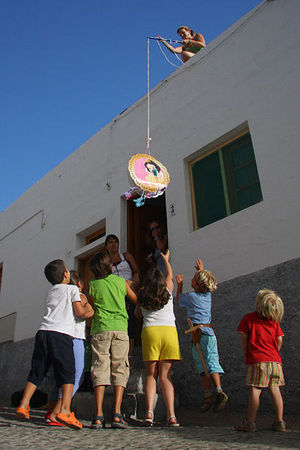Most of us associate the pinata with Mexican fiestas and fun. Children try to break the bright treat-filled container with a stick, hoping to puncture it so they can rush to gather treats. But what is the history behind the pinata? What does it symbolize? Where did it come from? Although the pinata is largely associated with Mexican/Latin American culture, this practice does not originate in Latin America, but in Africa!
The pinata today is practiced as a Christian celebration in Latino cultures. It symbolizes the struggle of man and his faith. The traditional Mexican pinata looks like a sputnik with seven points that symbolize the seven deadly sins: greed, gluttony, sloth, pride, envy, wrath and lust. The person attempting to break the pinata represents the good overcoming the evil.
It was the Spanish conquistadors that were credited for bringing the pinata to Mexico. The Spanish missionaries used the pinata as a tool to help them get the attention of the indigenous people and convert them to Christainity. In Spain, the pinata was brightly colored so that it would grab the attention of a innocent person. The candies and fruit inside were seen as the temptations of the Devil. The blindfolded person hitting the pinata represented the “blind faith”, and the stick he/she was using represented “goodness”. After the pinata was finally broken, the candies gathered were seen as a “just reward”. The moral of their ceremony: “all are justified through faith”. Originally, the Spanish pinata was a clay container called “la olla” (pot) and was not decorated.
The Spanish pinata came from the pignatta of Italy. The pignatta, or “fragile pot”, was made of clay and filled with trinkets, jewelry, or candies. It is said that it was Marco Polo who first brought the pignatta to Italy.
The Italians, in turn, developed the pignatta from the Chinese “pinata” of their spring agricultural ceremony. The Chinese designed their containers in the shape of animals (cows, bulls, etc.), and the colors used were representative of the conditions that were going to occur throughout the year. The pinatas were filled with seeds. The Chinese used sticks of various colors to break the pinata, and after it was broken the decorative paper that covered it was burned. Those present would rush to collect the ashes, as they brought good luck for the entire year.
The Aztecs had an important spiritual ritual that included a pinata. To celebrate the God of War, Huitzilopochtli, priests put a clay pot on a pole inside the temple. The pot was filled with tiny treasures, and the pots were decorated with beautiful feathers. They used a stick or club to break the pot, and the treasures that fell to the feet of the God’s image were offerings.
The original ceremony, however, has its origins in Africa. It was originally called the “Sala” or “Sara” ceremony, and is practiced throughout Africa until today. Djefa, or abundance, is a key component in this ceremony. A large number of people gather while the host carries a large bowl of food over his head, avoiding his guests who try to get the food while he is carrying it. As the host presents the food, the guests all dig in, chaotically eating from the same bowl. This, of course, creates an energy of disorder and chaos, and the bowl usually ends up falling on the ground. The food spilled on the ground symbolizes the Gods’ happiness with the energy created.
People of today enjoy the pinata during many celebrations, such as Christmas and birthday parties. Most schoolchildren have had the experience of creating a pinata, and most adults have attempted to hit one at least once in their lives. While pinatas of today are considered a fun game in western culture, the spiritual aspect of the traditional ceremony continues to play a role in indigenous societies.



